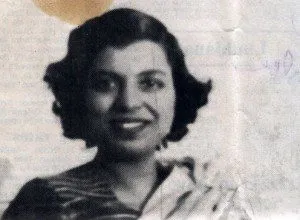Share This Article
Urmila ?Eulie??Chowdhary is a name rarely heard in Indian architecture history when talking about the Indian proteges of Le?Corbusier,?at the time of the Chandigarh project. Honestly, it is not surprising?considering?the profession is still?extremely?male-dominated. Eulie managed to find a way to evade the strict societal norms that existed in a very new post-independent India and certainly carved a path for herself despite being a woman. She is credited as being the first Indian female architect, while some sources also say she might be the first female architect in all of Asia. Eulie Chowdhury has contributed to architecture, landscape architecture, and design and is also a teacher and writer. Eulie Chowdhary is many things, but what she?is the most to young women pursuing architecture is?nothing less than that of an inspiration. Read on to?find out?more about this remarkable woman and the first female Indian architect.
Early Life and Education
Eulie Chowdhury was born in Shahjehanpur, Uttar Pradesh?in?1923. She graduated with?a Cambridge School Certificate from Kobe, Japan, studied architecture at the University of Sydney and?the Julian Ashborn School of?Art’s?Conservatory of Music in Sydney, and obtained a degree in ceramics from Englewood, New Jersey. She spent her childhood travelling the globe because her father was a diplomat. Her spouse, Jugal Kishore Chowdhary, was employed by the Punjab government as a consulting architect. She came from a liberal and elite family?that?didn?t?stop her from pursuing her artistic inclinations. She went on to become the first woman architect in India.
The Chandigarh Project

After working in the USA for a while, Eulie Chowdhary joined the dream team of Le Corbusier and took on the most ambitious project that India had seen at the time. Beginning with the High Court, the first building Le Corbusier designed, Eulie assisted in?the careful drawing of?the Martyrs Memorial, Geometric Hill, and the Tower of Shadows, three of the?city’s?most notable contemporary monuments. Together with Pierre Jeanneret, she designed several schools and ministerial homes.?She was a pioneering woman architect who played a?key?role in creating the?wood and furnishings for the?city’s?government offices.
Eulie Chowdhury’s?wooden furniture is one of her most intriguing architectural accomplishments.?It was an adaptation of?a design that?Le?Corbusier’s?cousin and collaborator Pierre Jeanneret?had?originally created.?Her furnishings adorned government buildings and offices in Chandigarh, including the Capitol Complex, Gandhi Bhavan, and Punjab?University’s?Guest House and Library. The furniture was inexpensive, squat, modular, and designed to fit the Indian body type. In general, Chowdhury incorporated Le?Corbusier’s?ideas and scale into her architectural designs, perfectly illustrating the concepts of geometric compositions and material honesty. She also created a unique vocabulary of modernist design of her own. She valued economy and workability equally with boldness and simplicity.

Expertise and Contributions
For the Indian architects at Chandigarh, a new chapter began with the departure of Corbusier and Jeanneret. Eulie Chowdhury and a few others were in charge of the second?round of planning. The Government Polytechnic College for Women in Sector 10, the Home Science?College’s?hostel block in Sector 10, St.?John’s?High School, and the government schools in Sectors 20, 37, and 38 are a few of the structures she designed. An excellent illustration of early modern architecture is the Polytechnic building. The?project’s?hostel block, which contrasts a concrete staircase element with a lot of brickwork, is another?great?example of modernist expression and one of the finest examples of Eulie Chowdhury’s Architecture. It features recessed windows framed by concrete bands, with the same emphasis on horizontality. Above all,?Chowdhury’s?attention to detail is evident in his use of Le?Corbusier’s?”The Modular”?to frame the windows, which breaks up the monotony of the?buildings’?geometric facade on the Home Science campus.

Eulie was the director of the New Delhi School of Planning and Architecture from 1963 to 1965. During this period, Eulie also translated Le Corbusier’s book “The Three Human Establishments” into English. ‘Those Were the Days’ is the book she wrote about her time spent working with Corbusier in Chandigarh. She served as a translator between Corbusier-Jeanneret and the Indian employees in the Architecture Department because she spoke French very well. She frequently contributed to numerous international architectural publications, including Casabella, Architectural Design, and Progressive Architecture.

From 1970 to 1971, Eulie was the first female chief architect for the state of Haryana. She was the first female chief architect of Chandigarh, overseeing the second phase of city planning from 1971 to 1976. She was appointed Punjab’s Chief Architect in 1976. Although she left the government in 1981, she continued to work on other initiatives and projects during her retirement. Eulie was the first female elected member of the Royal Institute of British Architects and a fellow of the Indian Institute of Architects.
Beyond Architecture
Eulie?s contributions go beyond the architectural realm and helped shape Chandigarh’s artistic and cultural figments. Her contributions were instrumental to the creation of Alliance Francaise in Chandigarh in 1983. Being a famous Francophile, she became its first president. She also set up the Chandigarh Amateur Dramatics Club which changed the dramatic scenery of the city of Chandigarh. She had an inclination towards arts as well and has even exhibited her paintings!
It is sad to realize her efforts went unnoticed by the mainstream media even though her works enhanced the architectural vocabulary of Chandigarh. Known rightly as the ?Great Dame of Modern Architecture?, Eulie made changes not just to architecture, but the arts and culture of Chandigarh through various efforts. Let us hope another Eulie Chowdhary won?t go unnoticed in our time, that another woman will get credit where it is due and not sing their praises after 100 years.
Sources
- https://worldarchitecture.org/articles/cvnnz/urmila_eulie_chowdhury_indiais_first_woman_architect_as_i_know_her.html#google_vignette
- https://www.re-thinkingthefuture.com/know-your-architects/a1083-eulie-chowdhury-first-known-woman-in-indian-architecture/#google_vignette
- https://www.tribuneindia.com/news/features/standing-out-remembering-eulie-chowdhury-the-only-indian-woman-architect-in-le-corbusiers-chandigarh-project-team-553396
- https://www.thebetterindia.com/185332/urmila-eulie-chowdhury-india-first-woman-architect-chandigarh/#google_vignette
- https://www.thetilesofindia.com/global-architects/the-journey-of-urmila-eulie-chowdhury


